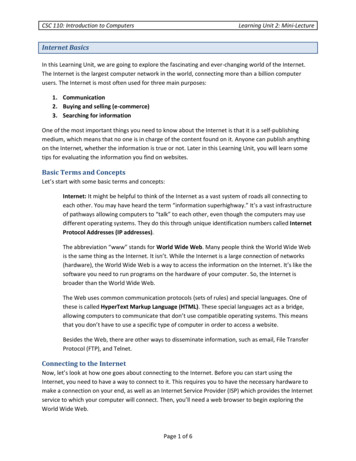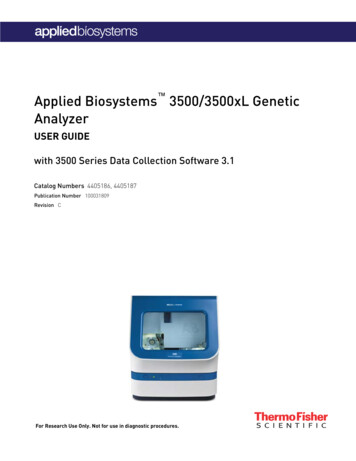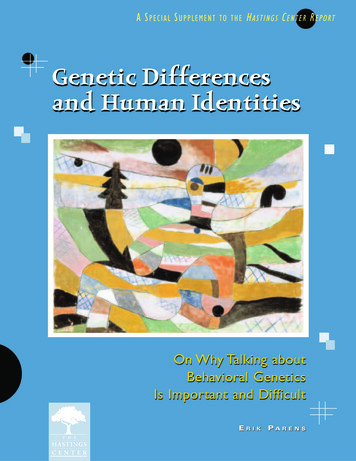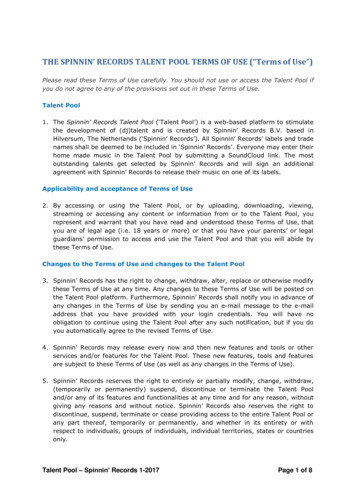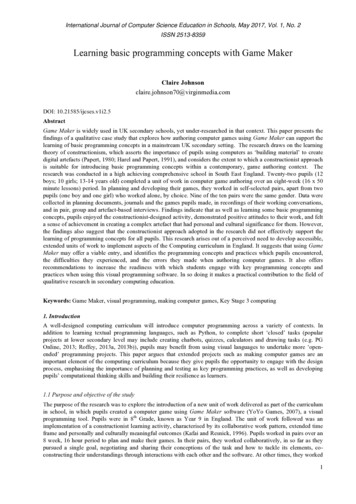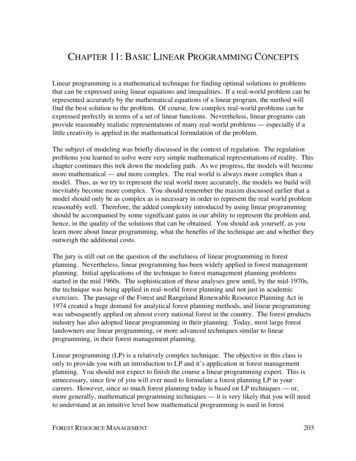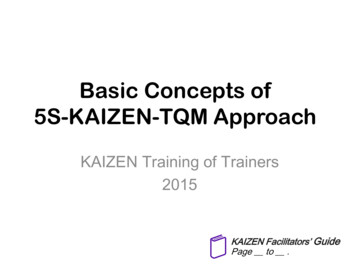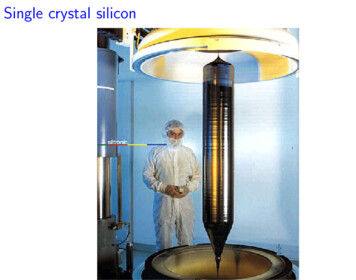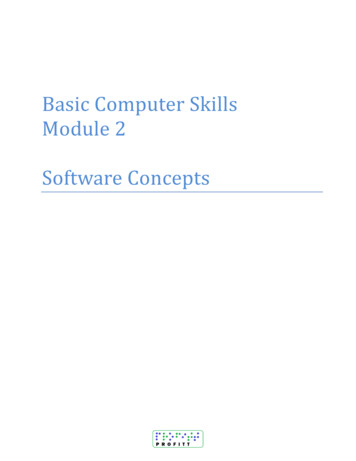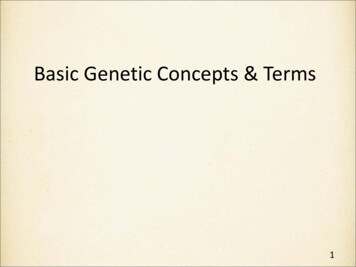
Transcription
Basic Genetic Concepts & Terms1
Genetics: what is it? What is genetics?– “Genetics is the study of heredity, the process in which aparent passes certain genes onto their cy/article/002048.htm) What does that mean?– Children inherit their biological parents’ genes thatexpress specific traits, such as some physicalcharacteristics, natural talents, and genetic disorders.2
Word Match ActivityMatch the genetic terms totheir corresponding partsof the illustration.base paircellchromosomeDNA(Deoxyribonucleic Acid) double helix* genes nucleus Illustration Source: Talking Glossary ofGenetic Termshttp://www.genome.gov/glossary.cfm?key chromosome3
Word Match Activitybase paircellchromosomeDNA(Deoxyribonucleic Acid) double helix* genes nucleusnucleus cellbase pairIllustration Source: Talking Glossary ofGenetic Termshttp://www.genome.gov/glossary.cfm?key chromosomechromosome(doublehelix)DNAgenes4
Genetic Concepts Hdescribes how some traits arepassed from parents to their children. The traits are expressed by g, which aresmall sections of DNA that are coded forspecific traits. Genes are found on ch. Humans have two sets of(hint: a number)chromosomes—one set from each parent.5
Genetic Concepts Heredity describes how some traits arepassed from parents to their children. The traits are expressed by genes, which aresmall sections of DNA that are coded forspecific traits. Genes are found on chromosomes. Humans have two sets of 23 chromosomes—one set from each parent.6
Genetic TermsUse library resources to define the following words and writetheir definitions using your own words.– allele:– genes:– dominant :– recessive:– homozygous:– heterozygous:– genotype:– phenotype:– Mendelian Inheritance:7
Mendelian Inheritance1. The inherited traits are determined by genes thatare passed from parents to children.2. A child inherits two sets of genes—one from eachparent.3. A trait may not be observable, but its gene can bepassed to the next generation.8
Mendelian InheritanceEach person has 2 copies of every gene—one copyfrom mom and a second copy from dad. These copiesmay come in different variations, known as alleles,that express different traits.For example, 2 alleles in the gene for freckles areinherited from mom and dad:– allele from mom has freckles (F)– allele from dad no freckles (f)– child has the inherited gene pair of alleles, Ff(F allele from mom and f allele from dad).9
Pre‐lesson Activity slide notes for suggested discussion guides for teachersSlide 1:This set of slides can be used as a review or introduction of basic genetic concepts thatstudents should know before the Lessons 1 and 2.Slide 2:Conduct a brief class discussion to assess students’ knowledge and assumptions aboutgenetics, while providing the information to those students who may not have any priorknowledge.Slice 3:Hand out the Word Match Activity worksheet and ask students to work in pairs to completethe worksheet. If needed, tell students that “double helix*” is paired with another term,and that both terms should be placed in one of the six areas indicated on the illustration.Slide 4:Have students volunteer the answers and clarify that “double helix” is the structure of DNA.Slide 5:Use this overhead for students to complete the 4 sentences.Slide 6:Have students volunteer their answers, and help students understand that the inheritedtraits are passed from one generation to the next as the parents’ chromosomes are copiedand passed to their children.Slide 7:(Optional) For this task, pre‐arrange with a school librarian or media specialist to providestudents with the computers with the web sites, “Talking Glossary of Genetic Terms”(http://www.genome.gov/10002096) and/or “DNA from the Beginning’s Classical Genetics”(http://www.dnaftb.org/dnaftb/), in addition to other reference materials student pairs canused to complete the task.Hand out the Basic Genetic Terms worksheet and provide reference materials for studentsto use in completing the worksheet.Have student pairs take turns in sharing their definitions and examples of the terms. (Seethe Basic Genetic Terms for Teachers for sample definitions and examples.)Slide 8:Review key concepts of Mendelian Inheritance with students. For #3, ask students whatsituations may call for an unobservable trait to be passed from parents to children. Studentsmay be able to apply their understanding of dominant and recessive traits where parentswith both dominant and recessive traits only show dominant traits while being able to passtheir recessive traits to the next generation.Slide 9:Review with students the term “allele” (a variant form of a gene) and help studentsunderstand that each gene has a pair or two alleles—one allele from mom and the otherfrom dad.
Genetics in Harry Potter’s WorldLesson 1 Phenotypes & Genotypes Dominant & Recessive Traits Punnett Square1
Genetics in Harry Potter? What types of inherited genetic traits aredescribed in the Harry Potter series?2
Inherited Physical Traitsin Harry Potter"All the Weasleys have red hair, freckles, andmore children than they can afford."-- Draco Malfoy (Sorcerers Stone, Ch.6)He was almost twice as tall as a normalman and at least five times as wide.(Sorcerer’s Stone, Ch.1)Harry had a thin face, knobby knees,black hair, and bright green eyes.(Sorcerer’s Stone, Ch.1)A pale boy with a pointed face and whiteblond hair, Draco greatly resembled hisfather. His mother was blonde too.(Goblet of Fire, Ch.8)3
Applying Genetics tothe Harry Potter Characters What are some phenotypes (observable traits)described in the four excerpts from the HarryPotter books?4
Applying Genetics tothe Harry Potter Characters What are some phenotypes (observable traits)described in the four excerpts from the HarryPotter books?– Freckles– Hair color– Eye color– Height5
Applying Genetics tothe Harry Potter Characters A genetic trait can be described in two ways:– Phenotypes are observable traits resulting fromhow one’s genes are expressed. Ex., hair color, atalent, sickle cell disease, etc.– A Genotype consists of two letters that representa gene’s allele pair that results in a phenotype.6
Example: Freckles Two possible phenotypes for freckles are:– Has Freckles (observable)– No freckles (observable) A genotype for freckles is indicated by two alleles inone of the genes that causes freckles. The possiblealleles using the first letter of the trait “f” are:– F (dominant) Has Freckles– f (recessive) No frecklesQuestion: Using F and f, what are possible genotypesof the allele pair for freckles?7
Freckles: Genotypes & PhenotypesQuestion: Using F and f, what are possiblegenotypes of the allele pair for freckles?Genotype(alleles inherited from parents)Phenotype(physical appearance)FF has frecklesFf has frecklesff no frecklesOne dominant allele (F) is sufficient for its trait (hasfreckles) to be observable, but both alleles have to berecessive (f) for the recessive trait (no freckles) to beobservable.8
Example: Red Hair In one of the genes that determines hair color, redhair is recessive to brown hair. One way to describethese hair color alleles are:– Red hair r (notes recessive red color)– Brown hair R (notes dominant brown color)Question: Using r (red hair) and R (brown hair) alleles,what possible genotypes of the allele pair are there?Phenotype (appearance)Genotype (allele pair)9
Example: Red HairQuestion: Using R (brown hair) and r (red hair) alleles,what possible genotypes of the allele pair are there?Phenotype (appearance)Genotype (allele pair)RR brown hairRr brown hairrr red hair10
Punnett Square:Heredity Prediction Diagram11
Punnett Square: Freckles Case 1Mom has freckles and dad has none. Andeach parent has a homozygous genotype(the two alleles in the gene are the same).Their genotypes are:Mom Dad 12
Punnett Square: Freckles Case 1The parents’homozygousgenotypes are:Mom F FDad Punnett Squareff13
Punnett Square: Freckles Case 1The parents’homozygousgenotypes are:Mom F FDad FFfffUsing the parents’genotypes, each innersquare is filled with apossible genotype fortheir child.f14
Punnett Square: Freckles Case 1The parents’homozygousgenotypes are:Mom F FDad FFfFfFffFfFfffAll possible genotypesof their children have afreckle-dominant allele,predicting a 100%chance of their childrenhaving freckles.15
Punnett Square: Freckles Case 2What happens if both mom and dad havefreckles, and their genotypes areheterozygous (the two alleles in the geneare different)?Their genotypes are:Mom Dad 16
Punnett Square: Freckles Case 2The parents’heterozygousgenotypes are:Mom F fDad Punnett SquareFf17
Punnett Square: Freckles Case 2The parents’heterozygousgenotypes are:Mom F fDad FfFFfUsing the parents’genotypes, each innersquare is filled with apossible genotype fortheir child.f18
Punnett Square: Freckles Case 2The parents’heterozygousgenotypes are:Mom F fDad FFfFFFfFfffFfThere is a 75% probability fthat their child will havefreckles, or a 25% chanceof a child with no freckles.19
Punnett Square: Weasley FamilyAll Weasley children have freckles and red hair. Usea Punnett Square to predict the most likelygenotypes of their parents, Molly and ArthurWeasley, for the two traits.Use the following allele possibilities that weidentified previously:––––r (notes recessive red color) Red hairR (notes dominant brown color) Brown hairF (dominant) Has Frecklesf (recessive) No freckles20
Punnett Square: Weasley FamilyAll Weasley children have freckles and red hair—100%probability. Possible genotypes for their red hair(recessive trait) and freckles (dominant trait) are: rronly for red hair and Ff or FF for freckles. The PunnettSquares show the following genotypes for the children:rrrrFf/FFFf/FFrrrrFf/FFFf/FFBoth parents have rr.At least one parent has FF.21
Punnett Square: The PottersQuestion 1: Harry has dark/brown hair like hisfather, but his mom had red hair. Using thegenotypes of rr, Rr, and RR, what possiblegenotypes does each of the Potters have?Questions 2: Harry marries Ginny who has red hair.What are possible genotypes of their children’s haircolors?Use a Punnett Square to demonstrate how youarrived at your answers.22
Punnett Square: The PottersQuestion 1: Harry has dark/brown hair like hisfather, but his mom had red hair. Using thegenotypes of rr, Rr, and RR, what possiblegenotypes does each of the Potters have?The phenotypes of the Potters are:James Potter (dad)—dark/brown hairLily Potter (mom)—red hairHarry Potter—dark/brown hair23
Punnett Square: The PottersUsing the genotypes of rr, Rr, and RR, what arepossible genotypes for Harry’s parents?– Mom-Lily (red hair) rr– Dad-James (dark hair) Rr or RRrrrRRrRrThe parents’ genotypes lead to 2 Punnett squares.24
Punnett Square: The PottersGiven Harry’s parents’ possible genotypes, the twoPunnett Squares can be completed as follows:rrrrR RrRrR RrRrr rrrrR RrRrIn this situation, the only possible genotype for Harry’sdark hair is Rr.25
Punnett Square: The PottersQuestions 2: Harry marries Ginny who has red hair.What are possible genotypes of their children’s haircolors?26
Punnett Square: Harry & GinnyHarry marries Ginny who has red hair. What are thepossible genotypes of their children’s hair colors?First, what are the genotypes for Harry’s and Ginny’shair colors?Harry’s genotype RrGinny’s genotype rr27
Punnett Square: Harry & GinnyHarry marries Ginny who has red hair. What arepossible genotypes of their children’s hair colors?Given Harry and Ginny’s genotypes, Rr and rr, wecan fill in the Punnett Square for their children’sgenotypes.rrTheir children have a 50%chance of being eitherred- or dark-haired.R RrRrr rrrr28
Human Mendelian Trait Examples Achoo Syndrome- People with this sneeze as a reflexwhen they see sunlight, after having been in a darkroom. It’s a dominant trait. Ear wax (wet/dry)- Wet ear wax, or ear wax that isbrown and sticky, is the dominant trait. Dry ear wax,or ear wax that is flaky, dry, and grayish-brown, isrecessive. Advanced Sleep Phase Syndrome- People with thisgo to bed and wake up unusually early. It’s adominant trait.29
Lesson 1 slide notes for suggested discussion guides for teachersSlide 1:Tell students that they will be applying the genetic terms they reviewed previously to someof the Harry Potter characters. If possible, display the Basic Genetic Terms Worksheet forTeachers for students to refer to as needed during the lesson.Slide 2:Conduct a brief discussion to help students identify examples of genetic physical traitsobserved in different characters in Harry Potter.Slice 3:Read aloud these excerpts as examples of possible genetic traits described in the series.Slide 4:Review the definition of phenotype from the Basic Genetic Terms for Teachers sheet ondisplay, and have students identify some of the phenotypes, observable traits, described inthe excerpts on slide 3.Slide 5:Let students know that they will be exploring the phenotypes and genotypes of these fourphysical traits.Slide 6:Remind students about the terms phenotypes and genotypes, and help students understandthat a genotype contains the allele pair containing genetic codes that results in a phenotype.Slide 7:Model how to identify phenotypes and genotypes for a genetic trait using freckles as anexample. Discuss and help students understand that genotypes are often represented by aletter from a trait, and that an upper‐case letter connotes a dominant trait and a lower‐casefor a recessive trait.Slide 8:Demonstrate how a genotype consists of two letters that represent the two or pair of allelesinherited from two parents. And apply the definitions of the terms, dominant and recessivefrom Basic Genetic Terms for Teachers, to the gene responsible for freckles—when a genehas an allele pair with one dominant and the other recessive traits, the dominant traitoverrides recessive one. You can also reintroduce the term, heterozygous which applies toan allele pair with two different forms of the gene.Slide 9:Have students think aloud about what the possible allele letters are for red hair color that isrecessive to the brown color. Ask students how they would respond to the question inidentifying possible genotypes and their corresponding phenotypes for this example.Slide 10:Provide the answer for the question. Reiterate that the dominant trait becomes observableor expressed over the recessive trait. At least one allele with a dominant trait in the allelepair of a gene results in the dominant trait phenotype, while the recessive trait phenotyperequires that both alleles in the gene have to be recessive.
Slide 11:Introduce the Punnett Square to students as a graphic way to evaluate probability andpossibility of genotypes of parents and children. If appropriate, provide an introductionusing the suggested web sites in the Background Information section of the lesson plan website.Slide 12:Review the terms, homozygous and heterozygous, from Basic Genetic Terms for Teachers ondisplay. Ask students to determine the genotypes of parents with freckles using the earlierexample used in the class. Guide students to justify their answers.Slide 13:Clarify the answers and justification for them. Model how the word “homozygous” is used tosolve the parents’ genotypes for freckles.Slide 14:Demonstrate how both parents’ genotypes are placed on the square before determiningtheir children’s possible genotypes.Slide 15:Allow students to explore how the Punnett Square helps determine the children’s possiblegenotype(s) and their probability.Slide 16:Conduct a brief question‐and‐answer session with the slides 16‐19. Coach students in usingtheir knowledge to solve the question step by step.Slide 17‐18: Assess students’ understanding of how to use the Punnett Square and how they applygenetic terms and concepts through discussion. And help students work through anymisconceptions along the way.Slide 19:Ask or help students interpret the Punnett Square information into a probability/chance inpercentages.Slide 20:Guide students in using Punnett Square to determine the parents’ genotypes when theirchildren’s genotypes are known.Slide 21:Think aloud about how known genotypes of children can provide the probable genotypes oftheir parents. The Punnett Square is filled with the children’s possible genotypes (derivedfrom all of them having red hair and freckles) that are used to draw conclusions on thepossible genotypes of their parents.Slide 22:Distribute the Potters’ Hair Color handout to each student and have students work in pairsto answer the two questions on the handout. If needed, display slide 10 to remind studentsabout the genotypes they worked on between red and brown hair colors.
Have student pairs volunteer their answers, and guide their reasoning using slides 23‐25 forQuestion 1, and slides 27‐28 for Question 2.Slide 23:Ask students how the described hair colors of Lily, James and Harry Potter may helpdetermine their genotypes for that trait. If needed, clarify that different phenotypes,observable traits, result from different allele combinations of a genotype. This means theirdescribed hair colors provide information about the genotypes that resulted in theirrespective hair colors.Slide 24:Have students volunteer their answers to each question while providing details on how theyarrived at their answers. Confirm and correct based on the correct or false reasoning andanswers that students provide.Slide 25:Clarify that Harry cannot have RR genotype which also result in dark/brown hair color. Theonly possible genotype for his hair is Rr. Also ask students to consider what else the twoPunnett Squares show about the possible hair colors that Harry’s sibling could have. Guidestudents to think about the two different Punnett Squares and have them use thepercentage to indicate the probability of each. For example, one Punnett Square shows thatHarry’s sibling has 50% chance of having brown/dark or red hair. But the other PunnettSquare shows that his sibling will have brown/dark hair just like him—100% chance.Slide 26‐28: Restate Question 2 and ask students to volunteer their answer and explain how they arrivedat the answer.Slide 29:Display this Human Mendelian Trait Examples chart and distribute the Human MandelianTraits worksheet. Allow students to work in pairs and have student pairs share theirfindings. Collect the completed worksheet to evaluate students’ understanding of theconcepts covered during the lesson.
Genetics in Harry Potter’s WorldLesson 2 Beyond Mendelian InheritanceGenetics of Magical Ability1
Rules of Inheritance Some traits follow the simple rules of Mendelianinheritance of dominant and recessive genes. Complex traits follow different patterns ofinheritance that may involve multiples genes andother factors. For example,– Incomplete or blended dominance– Codominance– Multiple alleles– Regulatory genesAny guesses on what these terms may mean?2
Incomplete Dominance Incomplete dominance results in a phenotype that isa blend of a heterozygous allele pair.Ex., Red flower Blue flower Purple flower If the dragons in Harry Potter have fire-power allelesF (strong fire) and F’ (no fire) that follow incompletedominance, what are the phenotypes for thefollowing dragon-fire genotypes?– FF– FF’– F’F’3
Incomplete Dominance Incomplete dominance results in a phenotype that isa blend of the two traits in an allele pair.Ex., Red flower Blue flower Purple flower If the Dragons in Harry Potter have fire-power allelesF (strong fire) and F’ (no fire) that follow incompletedominance, what are the phenotypes for thefollowing dragon-fire genotypes:GenotypesPhenotypesFFFF’F’F’strong firemoderate fire (blended trait)no fire4
Codominance Codominance results in a phenotype that showsboth traits of an allele pair.Ex., Red flower White flower Red & Whitespotted flower If merpeople have tail color alleles B (blue) and G(green) that follow the codominance inheritancerule, what are possible genotypes and phenotypes?PhenotypesGenotypes5
Codominance Codominance results in a phenotype that showsboth traits of an allele pair.Ex., Red flower White flower Red & Whitespotted flower (both traits) If merpeople have tail color alleles B (blue) and G(green) that follow the codominance inheritancerule, what are possible genotypes and phenotypes?PhenotypesGenotypesBBblue tailGGgreen tailBGblue & green tail (both traits)6
Multiple alleles Multiple alleles have more than 2 variations.Ex., human blood type has 3 different allele variants,A, B, and O.GenotypesPhenotypesAA, AOA blood typeABAB blood typeBB, BOB blood typeOOO blood type7
Multiple Alleles: Human Blood typeIf parents have A(AO) and B (BB)blood types, whatare the possiblegenotypes andphenotypes of theirchildren?AOBB8
Multiple Alleles: Human Blood typeIf parents have A(AO) and B (BB)blood types, whatare possiblegenotypes andphenotypes of theirchildren?Genotypes: AB andBOPhenotypes: AB andB blood typesAOB ABBOB ABBO9
Regulatory Genes Regulatory genes regulate the expression of othergenes. For example, a regulatory gene may ‘silence’ anothergene from expressing its dominant trait. The Manxcat has no tail because it has a regulatory gene thatsilences the gene that expresses the tail. This tailsilencing gene is dominant and has possible alleles:S silences tail gene no tail (Manx cat)s doesn’t silence tail gene has tail (non-Manx cat)Question: Can 2 Manx cats without tails have a kittenwith a tail? Show your answer using a Punnett square.10
Regulatory Genes: Manx CatQuestion: Can 2 Manx cats without tails have a kittenwith a tail? Show your answer using a Punnett square.The possible alleles for the tail-silencing gene are:S no tail (dominant)s has tail (recessive)SsSOnly if both parent cats have theheterozygous genotype, Ss. Then,there is a 25% chance forstheir having a kitten with a tail.SSSsSsss11
Complex Traits in Harry Potter What kind of gene inheritance may beresponsible for Hagrid’s height, which isabout 12 feet? What is the genotype for Harry’s eyecolor? If he had any siblings, what colorswould their eyes be?12
Complex Trait: Hagrid’s Height Hagrid’s father was a wizard and his mother was agiantess. The normal heights for giants and wizardsare: Giants about 20 ft. & Wizard 5-6 ft. Given that Hagrid is described to be about 12 ft.,what type of genetic inheritance may be at work forHagrid’s height?13
Complex Trait: Hagrid’s Height Hagrid’s father was a wizard and his mother was agiantess. The normal heights for giants and wizardsare: Giants 20-25 ft. & Wizard 5-6 ft. Given that Hagrid is described to about 12 ft., whattype of genetic inheritance may be at work forHagrid’s height?Hagrid’s height is close to the average of the heights ofa wizard and a giantess, (5 20)/2 12.5 ft, which showsincomplete dominance.14
Complex Trait: Hippogriff Coats Hippogriff coats come in many colors, like horse coats; coatcolor has multiple alleles:– C chestnut (codominant with other colors)– W white (codominant with other colors)– B black (codominant with other colors) Draw a Punnett square for the parents of a red roan (CW)hippogriff. (“Red roan” means it’s covered in both white hairsand chestnut hairs.)One parent has a chestnutcoat (CC). The other has awhite coat (WW).15
Complex Traits: Hippogriff Coats Hippogriff coats come in many colors, like horse coats; coatcolor has multiple alleles:– C chestnut (codominant with other colors)– W white (codominant with other colors)– B black (codominant with other colors) Draw a Punnett square for the parents of a red roan (CW)hippogriff. (“Red roan” means it’s covered in both white hairsand chestnut hairs.)WWOne parent has a chestnutcoat (CC). The other has awhite coat (WW). 100% oftheir offspring will havered roan coats (CW).CCWCWCCWCW16
Complex-Trait Activity: Magical Ability(independent group activity)In the Harry Potter series, characters are born withor without magical ability. Those with magical abilityalso show very strong, normal or weak ability.Assuming that magical ability is inherited, identifythe possible phenotypes and genotypes of thefollowing characters: Harry, Hermione, Ron,Dumbledore, Aunt Petunia, and Mr. FilchHints: Start by identifying phenotypes which will provide possiblegenotypes. Also consider whether simple Mendelian or complex traitsapply to the magical ability traits.17
Complex-Trait Activity: Magical Ability(guided activity)In the Harry Potter series, characters are born withor without magical ability. Those with magical abilityalso show very strong, normal or weak ability.Assuming that magical ability is a genetic trait, whatare possible phenotypes and genotypes of thefollowing characters?Harry, Hermione, Ron, Dumbledore, Aunt Petunia,and Mr. Filch18
Magical Ability: Possible PhenotypesHow would you describe the following characters’magical reAunt PetuniaMr. Filch19
Magical Ability: Possible PhenotypesHow would you describe the following characters’magical ability?––––––Harry has strong magical abilityHermione has strong magical abilityRon has average magical abilityDumbledore has strong magical abilityAunt Petunia has no magical abilityMr. Filch has weak magical abilityThe descriptions divide into two different categories ofobservable traits—1) expression and 2) strength of magicalability, which may indicate two genes responsible for the ability.20
Magical Ability: Possible PhenotypesHow would you describe the following characters’magical ability?– Harry has strong magical ability– Hermione has strong magical ability– Ron has average magical ability– Dumbledore has strong magical ability– Aunt Petunia has no magical ability– Mr. Filch has weak magical abilityEach category of magical ability description represents a generesponsible for certain observable traits:Expression—has the ability or doesn’t have the abilityStrength—has strong, average, or weak magical ability21
Magical Ability: Possible GenotypesWhat are the possible genotypes that maycorrespond to the 2 genes (expression and strengthof magical ability) below?Gene 1: expression of magical abilityExpressed (witches & wizards)Not expressed (Muggles do not have magical ability)Gene 2: strength of magical abilityStrongAverageWeak (i.e., squibs)Hint: Are the two phenotypes complex traits and not simple Mendeliantraits? If so, what type of complex trait are they?22
Magical Ability: Possible GenotypesWhat are possible genotypes for the phenotypes ofexpressed and not expressed magical ability?– Two Muggle parents can have a child with magical ability, likeHermione Muggles must have a gene for magic that is notexpressed or silenced by another regulatory gene.– The possible alleles for the silencing gene are: S (dominant) ors (recessive). The genotypes of the allele pair for expressed ornot expressed phenotypes are:Expressed (witches & wizards) —ssNot expressed (Muggles) —SS, Ss23
Magical Ability: Possible GenotypesWhat are possible genotypes for the phenotypes ofthe strength of magical ability?– There are three phenotypes described for the strength ofmagical ability: strong, average, or weak.– Given “strong weak average”, the magical strength genewith M (strong ability) and M’ (weak ability) alleles affectedby incomplete dominance can produce the genotypescorresponding to the three different phenotypes:Strong ability —MMAverage ability—MM’ (incomplete dominance)Weak ability (i.e., squibs) —M’M’24
Magical Ability: Possible GenotypesSummary of phenotypes and genotypesfor magical abilityThere are two genes related to magical ability.Possible genotypes of the two genes (two pairs ofalleles) are:Expressed (witches & wizards) —ssNot expressed (muggles) —Ss, SS (silencing gene)Strong —MMGood/normal—MM’ (incomplete dominance)Weak (i.e., squibs) —M’M’25
Magical Genes: Summary of 2 Genes Must be ss to have magical ability:– MMss very powerful wizard– MM’ss average wizard– M’M’ss very weak wizard (or squib) If you have at least one S you are a Muggle:– MMSs, MM’Ss, M’M’Ss a Muggle who could havechildren with magical ability with a spouse with at leastone s– MMSS, MM’SS, M’M’SS a Muggle who would never havechildren with magical ability26
Magical Ability: Characters’ GenotypesUsing the genotype summary, what are possiblegenotypes of each character?Harry: strong magical ability (MMss)Hermione: average magical ability (MMss)Ron: average magical ability (MM’ss)Dumbledore: strong magical ability (MMss)Aunt Petunia: no magical ability (MMSs, MM’Ss, M’M’Ss,MMSS, MM’SS, M’M’SS)– Mr. Filch: weak magical ability (M’M’ss)–––––27
Magic Runs in FamiliesAnswer the following questions and providereasoning for your answers:– Hermione’s possible genotype is MMss, indicating herstrong magical ability. What are possible genotypes ofHermione’s parents who are Muggles without the ability?– Harry Potter married Ginny Weasley. Will all of theirchildren have magical ability?– Could Dudley Dursley potentially have children withmagical ability?28
Hermione’s ParentsQuestion: What are possible genotypes of Hermione’sparents who are Muggles (no magical ability)? Hermione’s genotype is MMss.– For Hermione’s inherited ss, both of her Muggle parentsmust have Ss.– For Hermione’s inherited MM, both parents may have MMor MM’, but neither parents can have M’M’ allele pair. Hermione’s parents’ possible genotypes are:– MMSs, or MM’Ss29
Harry and Ginny’s ChildrenQuestion: Will all of Harry and Ginny’s children havemagical ability? Parents’ magical genes:– Harry’s genotype is MMss.– Ginny’s genotype may be MMss or MM’ss. Harry’s and Ginny’s children’s
Mendelian Inheritance. 1. The inherited traits are determined by genes that are passed from parents to children. 2. A child inherits two sets of genes —one from each parent. 3. A trait may not be observable, but its gene can be passed to the next generation. 8. Review key concepts

